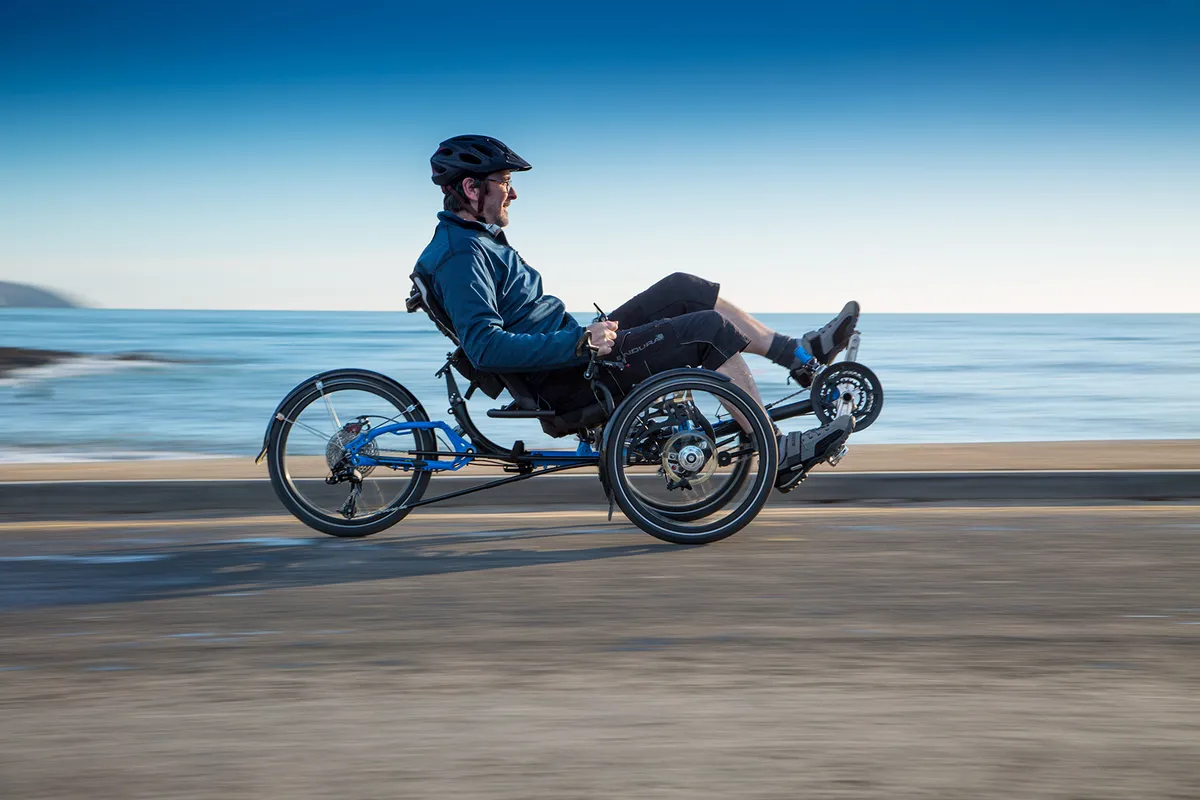Among the cycling clans and sub-clans of roadies, mountain bikers, commuters, downhill riders and the like, there’s one rarer breed that stands out – or rather sits out.
Recumbent bikes may look unusual to the uninitiated, but there are good reasons why some cyclists may choose a recumbent bike over a more conventional ‘double diamond’ design.
Here, we’ll run through the characteristics of a recumbent bike, why riders choose them, the different types of recumbent and a brief history.
What is a recumbent bike?

On a conventional bike, you sit on a saddle and, to a greater or lesser extent, lean forward; on a recumbent bike, you sit on a full seat and lean back.
There are also semi-recumbent designs, where you sit more or less upright.
Many recumbents have three wheels rather than two, making balance less of an issue, at least when riding in a straight line, although cornering on a tricycle is trickier than on two wheels, because you can't in general lean into the corner – and there's a risk of losing control.
Although manufacturers and users claim a host of benefits from recumbent bikes, the change from having your feet below you on a conventional bike to ahead of you on a recumbent bike requires some complex design solutions – of which there are a wide variety, as we’ll explain below.
A brief history of recumbents

Recumbent bikes are as old as the bicycle itself, with recumbent-like designs dating back to the 19th century.
They really took off in the 1930s, with recumbents with fairings pitched against conventional bikes in races. The recumbents usually won, so the UCI banned them from its competitions in 1934.
There’s still a thriving, if niche, race scene for recumbents, but their design stalled for around 40 years after the UCI ban – UCI killjoys are not a new phenomenon.
It was in the 1970s that a recumbent renaissance started, with new makers, new designs and renewed interest in laid-back cycling.
Why ride a recumbent bike?

With around 80 per cent of a rider’s input on a conventional bike going towards overcoming air resistance, the lower frontal profile of a rider on a recumbent bike can make it faster.
It’s fairly easy to fit a fairing to a recumbent for even greater aerodynamic improvement, or even a full outer shell for weather resistance, so recumbents can have an even greater edge over standard bikes in races.
On a recumbent, your lower back is supported, and there’s less strain on the arms and shoulders. The seat is likely to be more comfortable than a conventional saddle, and the lower ride position and the option for more than two wheels make balance easier too.

There’s some evidence that recumbents are safer, in part because there’s not so far to fall.
In addition, the lower part of the body is more likely to take the brunt of an impact than the head, although it’s still prudent to wear a helmet.
It has also been suggested that all-round vision is easier than on a standard frame, because you’re more upright. However, to counterbalance that, you’re generally lower down. Some riders of recumbents fit mirrors.
There’s also the small matter of problems with your private parts when you sit on a conventional saddle for hours.
There’s a whole collection of learned research papers with tiles such as ‘Nocturnal Penile Tumescence and Rigidity Testing in Bicycling Patrol Officers’ and ‘Genital Sensation and Sexual Function in Women Bicyclists‘ – you get the idea.
Recumbents or semi-recumbents can be a good choice for seniors, as well as those with erectile, back or other musculoskeletal problems – and they make good adaptive bikes.
There’s potentially less pressure on the legs too, so they can be easier to ride if you have joint problems.
What are the disadvantages of a recumbent bike?

On the downside, the seating position can make getting on and off a low-riding recumbent bike harder if you’re less flexible, which is why three wheels are better than two.
A low-riding recumbent may also have a lower road presence than a standard bike, which is why you’ll often see recumbent riders flying a pennant on a long pole to make them more visible. The low position makes seeing around and over parked cars or other obstacles harder.
In some designs, the ride position also puts much of the rider’s weight on the rear wheel, which may make steering and braking less predictable and, if the bike is driven via the front wheel, reduce traction.
Recumbents are made in much smaller numbers than most standard bikes, so they’re more expensive. The frame contains more material and is usually metal, so they weigh more too, compounded by the need in some designs to overbuild the frame to ensure rigidity.
The recumbent ride position, along with the weight of some designs, can make climbing slow, because the rider has to spin up a hill rather than being able to stand to exert more power on the pedals.
A long, low recumbent, or a multi-wheel recumbent, is likely to be more awkward to move around, or to transport in a car or other vehicle. In addition, there may not be much to get hold of to push the bike around.
Some designs also carry the risk of heel suck, where the heel hits the ground and the leg is pulled under the bike, which can result in severe leg injuries if the bike is moving fast.
Different types of recumbent explained

Recumbent bikes are usually custom-built in smaller volumes than conventional bikes, which means there’s plenty of scope for innovation and to vary the formula.
They may have smaller wheels than conventional bikes, in some cases with mismatched sizes.
You’re most likely to encounter a long-wheelbase recumbent bike, where the rider sits low between the front and rear wheels and the pedals are aft of the front wheel, driving the rear wheel – but there are other designs.
Shorter-wheelbase recumbent bikes typically place the rider higher up, above the wheels, so balance may be trickier. In some cases, the cranks may be placed ahead of the front wheel. You can also find recumbents that are powered via hand levers rather than using your legs.
While the hands of a rider of a conventional bike are above the front-wheel pivot, steering in a recumbent usually needs a mechanism to make it accessible from the rider’s leant-back position. That may mean chopper-style cowhorns to move the hand grips back, but other recumbents are steered via levers at the side of the rider, which turn the front wheel (or in some cases, the rear wheel) via rods or a belt.
Some recumbents are powered via the rear wheel and others via the front wheel. Rear-wheel drives need a long chain because the cranks are in general some distance ahead of the rear-wheel axle. They usually need chain tensioners part-way along the chain run.

Front-wheel drive means either the cranks and bottom bracket have to turn as the bike is steered or the cranks are kept rigid and the chain has to turn, guided through angles by pulleys. Other designs have the cranks attached directly to the front axle, with a geared hub to adjust speed.
There’s a whole range of recumbent bikes that aren’t bicycles at all. Recumbent tricycles are common and even four-wheelers are available, some designed for multiple riders.
Recumbent tricycles may have two rear wheels or two front wheels. And, as with all bike types, you can find electric recumbents if you want extra assistance.




